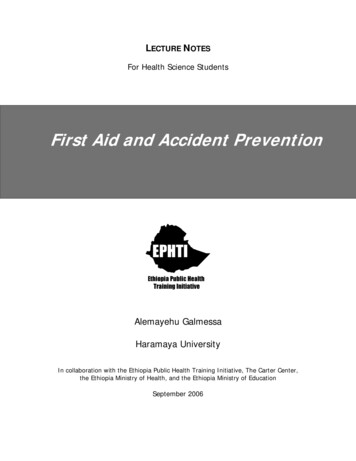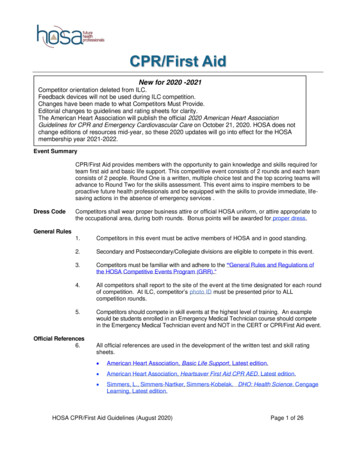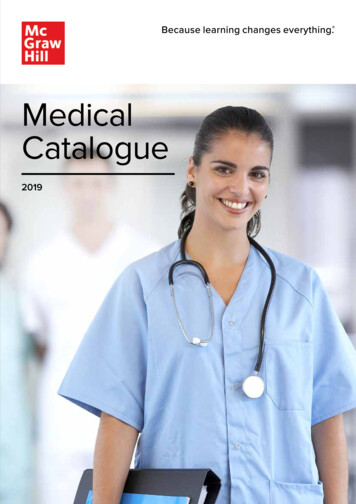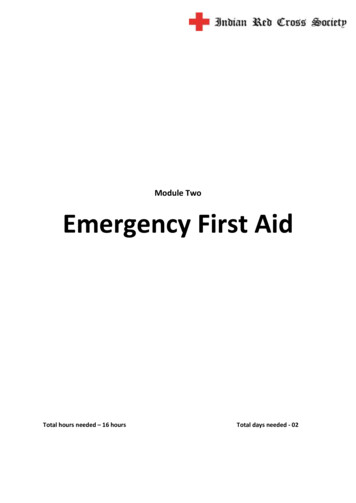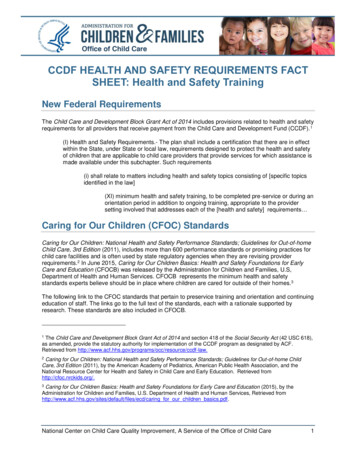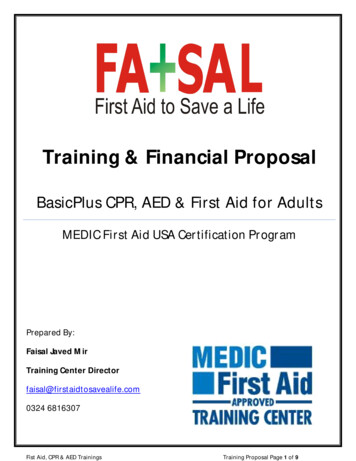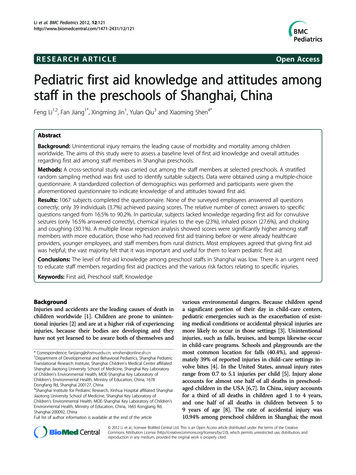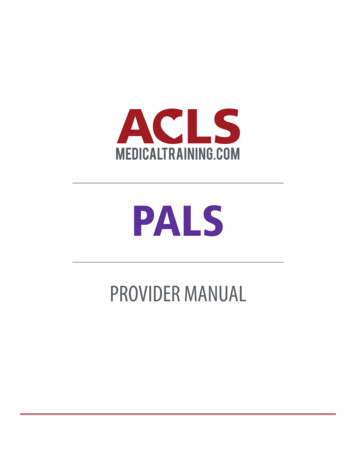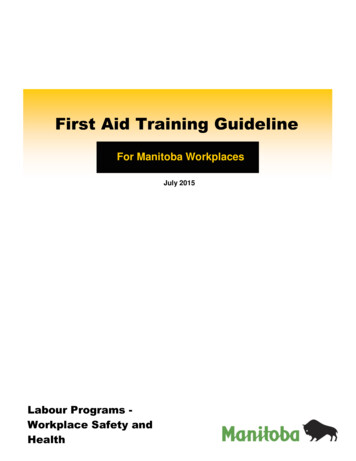
Transcription
First Aid Training GuidelineFor Manitoba WorkplacesJuly 2015Labour Programs Workplace Safety andHealth
Table of ContentsIntroduction . 3Minimum Requirements . 3First Aid Training Program Standards . 3Applying For Recognition . 4Forms for Agencies to Complete . 6General Information Checklist . 7Instructor Training Checklist . 9First Aider Course Content Checklists . 12First Aider 1 . 13First Aider 2 . 14First Aider 3 . 16Position Statement on Automated External Defibrillators and OxygenEquipment . 18Contact Information . 19Acknowledgement: Much of the information in this document has been borrowed from material produced by theGovernment of Alberta, Human Resources and Employment.
3IntroductionThis guide summarizes the requirements for agencies delivering first aid training courses inaccordance with The Workplace Safety and Health Act and Workplace Safety and HealthRegulation (M.R. 217/2006). It outlines the minimum requirements that agencies must have inplace to assure consistent delivery of high quality first aid courses for designated workplacefirst aiders in Manitoba. In addition to quality assurance requirements, first aid trainingprogram standards are listed and specific course content is outlined for three levels of first aidtraining.Minimum RequirementsFirst Aid Training minimum requirements are named in the following areas:A.B. First Aid Training Program StandardsApplying for Recognition:Standards SpreadsheetInstructor Training SpreadsheetParticipant Course Spreadsheet First Aider 1/ Emergency First Aid First Aider 2/ Standard First Aid First Aider 3/ Advanced First AidA. First Aid Training Program StandardsThe first aid training standards include course content with learning objectives, as well as thefollowing additional aspects of training.(1) Training goals and learning objectives for each aspect of a course’s content are a necessarypart of teaching and learning. To ensure that all course content is covered and meets thestandards set out for a particular level, all student manuals, instructor manuals, andadditional resources, must correspond with the evaluation standards for each course anagency offers. It is expected that instructor manuals provide guidance for instructors andindicate all mandatory course content along with required training times and suggestedteaching schedules.(2) Since first aid is skills-based, performance criteria are required for each learning objectivewithin each course. Competency checklists and criteria must be used.
4(3) First aid practice has a medical and/or research basis. To ensure that first aid training meetsrequired standards, agencies should have a medical advisor who is currently active inemergency or pre-hospital medicine. The Medical Advisor shall review all course materialsfrom a medical perspective on a regular basis. The name and relevant experience of themedical advisor, the frequency of the reviews and the date of the last review must beavailable.(4) In addition to a medical review, the content of each course that an agency offers shall beevaluated on a regular basis by agency representatives. The evaluation must include adescription of the process and methods used to evaluate course content and learningobjectives.(5) There are two aspects of certification portability that affects workplace first aiders and mustbe discussed in an agency’s Quality Management Plan.(a) Many designated workplace first aiders work in industries that cross provincialboundaries. Although not required, portability of certification to different provinces isdesirable.(b) Recognition of courses approved within the federal occupational health and safetyregulations is another program aspect that is desirable but not required.Agency submissions should include a statement that addresses both aspects of certificationportability.Applying for RecognitionThese Spreadsheets are designed to support preparation of a course for submission. Agenciesmust submit completed spreadsheets for each course.(1) Standards Spreadsheet/ChecklistThis outlines the information to submit so that an assessment of the agency’s qualityassurance and relevant program standards can be made.(2) Instructor Spreadsheet/ChecklistThe instructor checklist includes all requirements of the Instructor Qualifications andEvaluations section.
5(3) Participant Course Spreadsheet/ChecklistIf more than one course is included in the submission, a checklist must be completed foreach course.The aim of reviewing submissions is to help applicants meet all the standards required for firstaid course delivery. If standards are not met, it is an agency’s decision as to whether tocontinue with the approval process. Once standards are met, the agency will be placed on theList of Approved Courses. Submissions are made to the Chief Occupational Medical Officer,Workplace Health and Safety, Manitoba Department of Labour.First Aid Training Agencies are required to notify the Medical Director of any changes toprotocols and/or program materials. All revised materials submitted must be accompanied bythe rationale for the changes.
6Forms for Agency SubmissionsThe following checklists must be included with any submission.
7General Information ChecklistAgency Name:ItemInformation to Submit1. CourseinformationFor each course, send all course-relatedinformation as outlined in the Course InformationChecklist that follows.2. StudentEvaluationprocessesInclude both knowledge and skills assessmenttools and processes that are used to ensure firstaiders who are certified meet all required trainingstandards and competencies.3. First AidercertificationtrackingInclude an explanation of the process for issuingand tracking both Student and Instructorcertifications. Include an explanation of theprocess used to verify Student and Instructorcertification if their wallet card or certificate is lost.4. InstructorinformationComplete the Instructor Spreadsheet todemonstrate how the instructor training programmeets or exceeds the standards. All instructorswho deliver the agency’s courses must meet thestandards whether hired directly by the agency orcontracted as a third-party deliverer.5. RecordkeepingstandardsApplication should include an explanation of therecord keeping standards used. Policies andprocedures can be outlined; sample documentscan be included.6. Complaint anddisputeresolutionDescribe the process used for resolving anycomplaints about the course, material, instructor orany other matter pertaining to first aid training.7. QA for thirdparty providersExplain how quality assurance is maintained if thecourse(s) are taught by third-party providers.8. MakingchangesExplain the process for incorporating changes toboth protocols and program materials. Describehow often content is reviewed and revised and thebasis for the changes. In addition, identify whoreviews and revises course content.Please indicate referencedocument and pagenumberFor Office UseOnly— Comments —
8General Information Checklist (con’t)9. OrganizationalchartInclude an organizational chart that identifies theposition of those involved in developing anddelivering of the first aid policies, procedures andcontent relating to training. Also include thestructure for coordinating administrative and recordkeeping matters. Please show the relationship ofthe medical director who reviews the coursecontent on the organizational chart. If third partiesare contracted to deliver first aid training, include acopy of the tools, agreements, and processes usedto ensure the delivery of programs according to thetraining agency standards.10. MedicalAdvisorEvery agency should have a medical advisor whoreviews and approves course content on a regularbasis. This advisor must be currently active in theEmergency or Pre-hospital field. The submissionshould include the name and relevant experienceof the medical advisor, the regularity of the reviewsand the date of the last review.11. PortabilityInclude a statement as to whether your courses areaccepted in other provinces as well as federally.Indicate whether you recognize other agencies’courses, and please list the agencies and thelevels. For submissions from companies who doin-house first aid training only, simply state that thetraining is done only for the company, and only inManitoba. Include a copy of approval letters withyour submission.
9First Aid Instructor ChecklistAgency Name:Note: All of these requirements are prerequisite to First Aider 3 Instructor Training.Information to Submit(A) Provide evidence thatinstructor(s) complete an InstructorCertification training program of 30hours minimum duration thatincludes the following subjectareas:(i) principles of instruction;(ii) principles of adult learning;(iii) lesson planning;(iv) demonstration and lecturetechniques;(v) use of training aids;(vi) methods of studentevaluation; and(vii) pertinent legislation dealingwith worksite first aid.(B) Instructors certified todeliver First Aider 1 must haveproof of current qualification asa First Aider 2 or 3.(C) Instructors certified to deliverFirst Aider 2 must have proof ofcurrent qualification as a FirstAider 2 or 3.(D) Instructors certified to deliverReference to Course MaterialsFor Office UseOnly-Comments-
10First Aid Instructor Checklist (con’t)First Aider 3 must have proof ofcurrent qualification as a FirstAider 3.(E) Provide evidence that:(i) instructors be part of anevaluation process;(ii) instructors have athorough knowledge of andbe certified in, the First AidTraining Standards at thelevel they are required toteach;(iii) instructors’certification has amaximum expiry of 3years.(F) Upon recertification,instructors must:(i) demonstrateinstructional ability;(ii) participate incontinuing education;(iii) demonstrate first aidand CPR/AED skills at theappropriate level ofcertification;(iv) have actively taught inthe certification period;and(v) be current in coursecontent.(G) The agency must ensurethat each instructor deliveringtraining is evaluated on aregular basis to make sure thatthere is:(i) appropriate use ofinstructor materials;(j)(ii) an effectivepresentation style;(iii) coverage of thecomplete course curriculum;and(iv) evidence of first aid andCPR/AED practices that arecurrent.
11First Aid Instructor Checklist (con’t 2)(H) First Aider 3 Instructor:In addition to the First AidInstructor requirements, FA 3Instructors must completeInstructor Certification training atthe First Aider 3 level. This mustinclude all of the abovecomponents related to the FA 3skills and knowledge. Minimumadditional training time is 20 hours.The agency must maintain awritten record of each instructor’sevaluation results that is dated andsigned by the evaluator, and thatidentifies the course delivered.Each Instructor’s certificationdetails must be available to theMedical Director on request.
12First Aider Course Content ChecklistsPart 5 of the Workplace Safety and Health Regulations states that a certificate issued by a firstaid training provider is valid only if it specifies:(a)(b)(c)(d)The first aid training provider that issued the certificateThe title of the courseThe level of qualification (FA1, FA2 or FA3) for which the certificate is issued; andThe date it was issued and its expiry, which must not be more than three years afterthe date it was issued.
13First Aider 1Duration: Minimum 8 training hoursCertification Term: Maximum 3 yearsA person has the qualifications of a first aider 1 if he or she holds a certificate issued by a firstaid training provider showing that he or she has successfully completed at least eight hours infirst aid training that addresses the following topics:Course content(a) the role function andresponsibilities of the first aider(b) emergency scene management(c) patient assessment: primaryand secondary survey(d) basic anatomy and physiology,including body systems such asrespiratory, circulatory,musculoskeletal, neurological andintegumentarye) obstructed airway and otherbreathing emergencies(f) cardiovascular emergencies,such as heart attack and stroke(g) control of bleeding; bothinternal and external(h) signs and symptoms of shock(i) cardiopulmonary resuscitation:adult - one person rescue(j) trauma and other acute medicalsituations, bone and joint injury,head and spine injury, skindisruption (lacerations and burns)and poisoning(k) general precautions to preventblood and body fluid exposure(l) infection controlReference to course materialsFor Office UseOnly
14First Aider 2Duration: Minimum 16 training hoursCertification Term: Maximum 3 yearsA person has the qualifications of a first aider 2 if he or she holds one or more certificatesissued by one or more first aid training providers showing that he or she has successfullycompleted at least 16 hours in the following first aid and cardiopulmonary resuscitation trainingcourses:Course content(a) The first aid training thataddresses the topics requiredfor First Aider 1 plus thefollowing additional topics(i) interaction withhigher-level trained personneland medical care agencies,(ii) ambulance system,(iii) obstructed airway andother breathing emergencies,(iv) assessment andmonitoring of vital signs,(v) respiratory emergencies respiratory system review,management of airways,airway obstruction and chestinjuries,(vi) circulatory system review- heart attack and stroke,(vii) bleeding - wounds andcontrol of bleeding andbandaging,(viii) abdominal injuries system review by quadrant,(ix) stabilization - head, spineand pelvis injuries,(x) upper and lower extremityinjuries,(xi) medical emergencies epilepsy, diabetes and drugoverdose,(xii) assessment andtreatment of burns,(xiii) eye injury,Reference to course materialsFor Office UseOnly
15First Aider 2 (continued)(xiv) environmental illnessand injury - heat, cold andpoisonings,(xv) movement of a casualty carries;(b) Cardiopulmonaryresuscitation training thataddresses the followingtopics:(i) risk factors,(ii) signals and actions ofheart attack and stroke,(iii) airway obstruction prevention, causes andrecognition,(iv) entrance into theemergency medical servicessystem,(v) one rescuercardiopulmonary resuscitation(adult),(vi) treatment of an adult withan obstructed airway,(vii) turning of the casualtyinto the recovery position
16First Aider 3Duration: Minimum 70 training hoursCertification Term: Maximum 3 yearsA person has the qualifications of a first aider 3 certificate if he or she holds one or morecertificates issued by one or more first aid training providers showing that he or she hassuccessfully completed at least 70 hours in the following first aid and cardiopulmonaryresuscitation training courses:Course content(a) First aid training thatcovers the topics listed inclauses 2(a) to (l) and subclauses 3(a)(i) to (xv),appropriate to the First Aider 3qualification, plus the followingadditional topics:(i) the role, function,responsibilities of the firstaider - knowledge ofemergency medical system,the place of the first aider inthe system, other skill levels inthe system,(ii) different phases ofemergency medical care removal from immediatedangers,(iii) scene management triage,(iv) training in the use of firstaid equipment, e.g.: oxygen,bag-valve mask andmouth-to-mouth(v) anatomy and physiologyappropriate to the first aider 3qualification,(vi) airway management andthe use of first aid equipment(e.g.: bag valve, maskresuscitator, oxygenequipment),(vii) assessment and treatmentof common medicalemergencies - heart attack,cardiac arrest, stroke anddiabetes,Reference to course materialsFor Office UseOnly
17First Aider 3 (con’t)(viii) trauma to head, spine,chest, abdomen and pelvis multiple injury management,(ix) soft tissue injuries,(x) safe carries and transport,(xi) insect bites,(xii) burns - assessment andtreatment,(xiii) obstetrics: emergencydelivery and postpartumhemorrhage,(xiv) recognition of the acutesigns and symptoms of drugoverdose and treatment of theinjured worker,(xv) assessment andtreatment of the acuteabdomen (e.g.: distended ortender),(xvi) recordkeeping:preservation of informationnecessary for subsequentaction,(xvii) understanding andfamiliarity with relevantprovisions of the Act and itsregulations;(b) Cardiopulmonaryresuscitation training thatcovers the topics listed in subclauses 3(b)(i) to (vii),appropriate to the First Aider 3qualification, plus the followingadditional topics:(i) two rescuercardiopulmonary resuscitation,(ii) mouth-to-maskresuscitation(iii) spinal injuries
18Position Statement on Automated ExternalDefibrillators and Oxygen Equipment in theworkplace:If automated external defibrillators and oxygen equipment are available in the workplace, it isthe responsibility of the employer to ensure that: The staff who receives first aid training must also be trained in the proper use of thisequipment. A plan is implemented for placement and regular maintenance of this equipment. Regular exercises to test the plan and practice use of the equipment are scheduled atleast once annually for every shift. These must be documented and where correctionsand/or retraining are required, this must be completed and then the exercise must berepeated. A plan is implemented for follow-up of each event where the equipment has been used,including review of the event, debriefing staff and others involved in the event, andrestoring equipment to be ready for next use. This plan should be revised and reviewedas necessary.
19Contact information:To apply for recognition as an approved first aid training provider, sendcompleted submissions to:Chief Occupational Medical Officerc/o Workplace Safety and Health200-401 York AvenueWinnipeg, Manitoba, Canada R3C 0P8Or by Email: denise.koh2@gov.mb.caFor questions or concerns related to the content of this document, pleasecontact:Workplace Safety and Health BranchWinnipeg: . (204) 957-SAFE(7233)Toll Free in Manitoba: . 1 (855) 957-SAFE(7233)Select ‘Option orkplace Safety and Health Regulation Part 5: First AidWSH Approved Training ProvidersFor prevention resources and other safety and health information, visitwww.safemanitoba.com.
First Aider 1/ Emergency First Aid First Aider 2/ Standard First Aid First Aider 3/ Advanced First Aid A. First Aid Training Program Standards The first aid training standards include course content with learning objectives,


